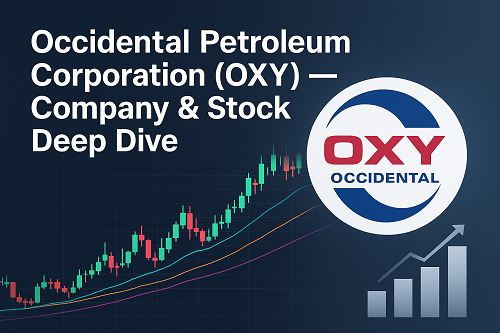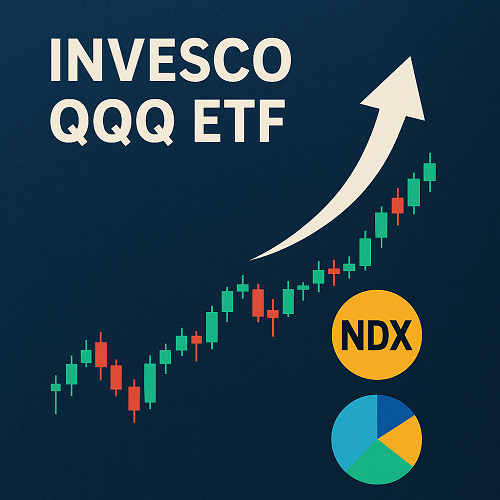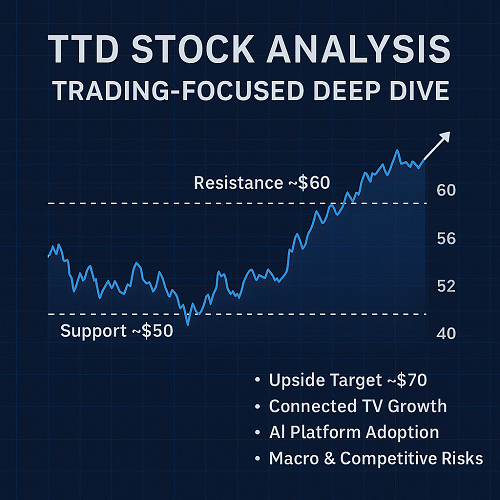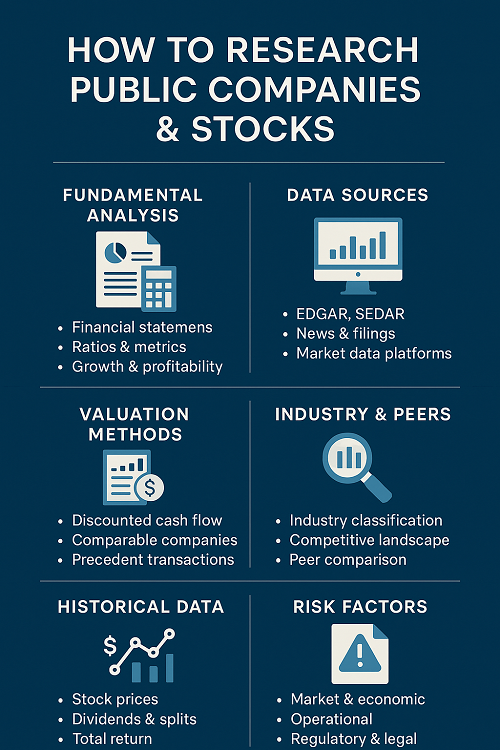Occidental Petroleum Corporation (OXY) is a U.S.-based energy company headquartered in Houston, Texas, engaged primarily in oil & gas exploration and production (E&P), as well as midstream activities and chemical manufacturing. Investors are keenly watching the Occidental Petroleum stock price, given the company’s significant impact in the energy sector.
- Founded in 1920.
- Business segments (per its profile):
- Oil & Gas: exploration, development & production of oil, condensates, natural gas liquids (NGLs), natural gas.
- Chemicals: manufacturing and marketing of basic chemicals (chlorine, caustic soda, chlorinated organics, vinyls etc).
- Midstream & Marketing: gathering, processing, transporting, storing oil, gas, NGLs, CO₂, power.
Strategic positioning
OXY has historically sought to be a vertical/multi-segment energy company — not just upstream, but with exposure in chemicals and processing. This gives it exposure to commodity cycles (oil & gas) but also to different industrial markets (chemicals).
However, recently (2025) Occidental Petroleum stock price is making strategic shifts: notably, it has agreed to sell its petrochemical/chemical unit (OxyChem) to Berkshire Hathaway Inc. for about US $9.7 billion.
That signals a refocusing back toward upstream oil & gas and debt reduction.
Key facts & numbers (quick snapshot)
- Market cap: ~$40 billion (approx) as of October 2025.
- Forward P/E, valuation metrics: For example, trailing P/E ~24-26×.
- Dividend yield: ~2.3-2.4 % (around $0.96 dividend, yield ~2.35 %) in recent data.
- Debt & cash: Total cash ~$2.3 billion; debt-to-equity ~66.8 % in recent quarter.
Industry & macro context
A. Oil & gas fundamentals
Since OXY’s main business is oil & gas exploration/production, macro factors play a huge role:
- Crude-oil price cycles: Upwards when supply is constrained or demand strong (global economic growth, emerging markets, supply disruptions). Downwards when there is oversupply, demand weakness or substitution/enforcement of ESG/renewables.
- Natural gas/NGLs: Regional specifics matter (U.S. shale plays, liquefied natural gas exports, regional pricing).
- Costs of production: For OXY, being heavily invested in U.S. operations (Permian Basin, etc) means cost structure and operational efficiency matter.
- Regulatory, ESG and transition risk: Oil & gas companies face increasing headwinds (climate policy, carbon pricing, demand risk over long horizon).
B. Chemicals & value-added segments (historical for OXY)
For the chemical business (OxyChem), industrial cycles, input cost volatility (feedstock, energy), global trade, environmental liabilities are major factors. Its sale signals OXY sees less strategic value in that segment vs upstream.
C. Competitive & peer context
OXY competes with other major upstream energy companies like Exxon Mobil Corporation (XOM), Chevron Corporation (CVX), Devon Energy Corporation (DVN). Watching peer metrics helps assess OXY’s relative positioning.
Financial analysis & valuation
A. Revenue, profitability, cash-flow
- Revenue (TTM): ~$27.15 billion.
- Net income (TTM): ~$1.73 billion.
- Profit margin: ~9.0 % (according to one data-set) for recent period.
- Return on equity (ROE): ~7.11 %.
- Free cash flow (levered) (TTM): ~$4.52 billion.
B. Valuation metrics
- P/E (trailing): ~24–26×.
- Price/Book: ~1.59×.
- Enterprise Value/EBITDA: ~5.90×.
These multiples show that the market may be pricing in moderate growth but also acknowledging risk in upstream.
C. Balance sheet & debt
- Debt/Equity: ~66.82 % in recent quarter.
- Cash on hand: ~$2.33 billion.
Given high capital requirements in E&P and commodity risk, debt and leverage are key risk factors.
Sale of OxyChem (to Berkshire) for ~$9.7 billion aims to reduce debt and strengthen the balance sheet.
D. Dividend & shareholder returns
- Dividend: ~$0.96 annual per share, yield about 2.3-2.4 %.
- Given the volatility of upstream, dividends in the sector are sensitive to commodity prices and capital allocation.
Recent major strategic events & catalysts
Sale of OxyChem to Berkshire Hathaway
- OXY has agreed to sell its petrochemical subsidiary (OxyChem) to Berkshire Hathaway for about $9.7 billion in cash.
- OXY plans to use ~$6.5 billion of the proceeds to reduce debt (which helps its leverage and interest expense profile).
- For Berkshire, the acquisition is a strategic play in chemicals; for OXY, it is a move back toward oil & gas core business.
- The market reaction was mixed—investors appear concerned about losing the chemicals diversification and possibly undervaluing the asset sold.
Execution in upstream & production
- OXY has had positive production trends and somewhat better earnings than expected in certain quarters, reflecting operational improvement.
- Nonetheless, upstream is still subject to commodity price risks, drilling cost inflation, regulatory/ESG risks.
Ownership & major shareholder dynamics
- Berkshire Hathaway (via Buffett) is a substantial shareholder in Occidental Petroleum stock price (over 28% stake as of certain filings) which gives strategic weight to its transactions and business moves.
- This relationship can be viewed as both a positive (stability, access to capital) and a possible risk if strategic mis-alignment emerges.
SWOT analysis
Strengths
- Established player with scale in the upstream oil & gas sector.
- Strong cash flow and ability to reduce debt with major asset sales.
- Backing by a heavyweight investor (Berkshire Hathaway) which can enhance credibility.
- Diversified operations (historically) across oil & gas, chemicals, midstream — provides operating flexibility.
Weaknesses
- High exposure to commodity cycles (oil & gas prices) which are volatile and externally driven.
- Historically weaker profitability metrics compared to best peers (ROE ~7 %).
- Debt levels still significant and upstream capital intensity means ongoing capital needs.
- Sale of chemical business may reduce diversification and increase upstream concentration risk.
Opportunities
- If oil prices rise (due to supply constraints, geopolitical risk, rising global demand) Occidental Petroleum stock price OXY stands to benefit.
- Debt reduction and improved capital structure could lead to higher shareholder returns or reinvestment.
- Operational improvements in cost, efficiency, targeting U.S. shale may yield margin expansion.
- Potential strategic positioning in CO₂ enhanced oil recovery (EOR) or carbon capture could emerge (given upstream footprint) — a long-term theme.
Threats
- Downturn in oil/gas prices (e.g., due to recession, pandemic, supply surge) can severely hurt earnings.
- Regulatory/ESG risk: global shift to decarbonisation, potential asset stranding, carbon cost risk.
- Environmental liabilities: upstream operations carry risk of spills, litigation, regulatory fines.
- Competition from renewables and shifting investor sentiment away from fossil‐fuels may limit valuation.
- Geopolitical risk (oil producing regions, sanctions, instability) can disrupt supply but also increase costs.
Price targets, analyst sentiment & valuation outlook
- Analyst consensus price target for OXY is in the ~$50.78 range (per one data point) which implies upside from current ~$40-41 levels.
- PEG (5-yr expected) is ~1.16 times, suggesting moderate growth expectations vs price.
- Relative valuation (P/E ~24-26×) is not ultra-cheap for an upstream oil company, implying the market expects steady cash flows but also recognises risk.
Scenario modelling
- Base case: Oil prices remain moderate (~US$70–85/bbl), OXY executes debt reduction, upstream operations stable, yield ~2.3 %, modest share price appreciation to ~$50 in next 12-18 months.
- Bull case: Oil prices rise significantly (e.g., supply disruptions, tightening global demand), OXY benefits materially, cash flows increase, debt declines faster, share price could reach $60+ or more.
- Bear case: Oil prices fall (e.g., global recession, oversupply), upstream margins shrink, debt becomes burdensome, dividend under threat, share price could drop into the $30s or lower.
Key metrics every investor should monitor
When tracking OXY, pay attention to:
- Crude oil price trends (WTI, Brent) and natural gas/NGLs pricing.
- Occidental Petroleum stock price OXY’s production volumes (barrels of oil equivalent per day), cost of production (breakeven pricing).
- Free cash flow generation and how it is allocated (debt repayment vs dividends vs share buybacks).
- Debt levels and maturity schedule; interest expense and leverage ratios.
- Asset sales and portfolio restructuring (like OxyChem sale) and resultant impact on business focus.
- ESG/regulatory developments: carbon pricing, emission reduction targets, litigation or environmental provisions.
- Analyst estimates for EPS/revenue and changes in consensus sentiment.
- Dividend policy and yield sustainability in different commodity price environments.
Risks & things to watch for
- Commodity volatility: Rapid movements in oil/gas prices can change the financial picture dramatically.
- Execution risk: Cost overruns, production declines, regulatory issues could hurt operations.
- Balance-sheet risk: If prices stay depressed and cash flows drop, debt burden may become serious.
- Strategy shift risk: Selling chemical business simplifies but also reduces diversification; if upstream suffers, less buffer.
- Transition risk: Long-term shift away from fossil fuels could reduce demand, increase cost of capital, lead to stranded assets.
- Environmental / litigation risk: Legacy liabilities (especially from chemical or upstream operations) could emerge unexpectedly.
Verdict & outlook
In summary, Occidental Petroleum is a meaningful player in the energy space with a significant footprint and clear strategic moves underway to improve its financial health (debt reduction via asset sale). For investors comfortable with commodity risk and the cyclicality of upstream energy, OXY offers:
- A moderate dividend yield (~2.3 %).
- Reasonable upside (given consensus price targets around ~$50+).
- Exposure to a possible rebound in oil/gas.
However, the risks are substantial: upstream volatility, regulatory/transition risk, and the fact that the market likely already prices much of the favorable scenarios (given its current valuation multiples).
From a timing standpoint, the stock may be more attractive if:
- Oil/gas prices show sustained strength.
- OXY delivers on debt reduction and shows improving margins.
- The macro environment supports energy stocks (rather than penalises them).
If you are seeking a more conservative energy investment or want less commodity exposure, this may not be ideal — but for those willing to ride the cycle, OXY is a contender.





 XAUT-USD
XAUT-USD  AMD
AMD  MARA
MARA  SHOP
SHOP  BULL
BULL  CL=F
CL=F